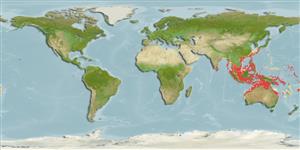Common names from other countries
Classification / Names / Names
Common names | Synonyms | Catalog of Fishes (gen., sp.) | ITIS | CoL | WoRMS
Environment: milieu / climate zone / depth range / distribution range
Ecology
Sessile; depth range 0 - 100 m (Ref. 101942). Tropical
Indo-West Pacific.
Length at first maturity / Size / Weight / Age
Maturity: Lm ? range ? - ? cm
Irregularly shaped. Hispid surface with steep-sided conical projections. Calcitic materials fills in grooves; ostia not visible. Oscula in the apex of the conules is hard to see underwater. Hard and corky texture, not easily compressible and hard to tear. Brown; dark conules than the rest of the body. Tightly packed spicules that criss-crosses each other, with some potruding to the surface.
Life cycle and mating behavior
Maturity | Reproduction | Spawning | Eggs | Fecundity | Larvae
Members of the class Demospongiae are hermaphroditic. Life cycle: The zygote develops into parenchymella larva (free-swimming) before settling down on a substrate where it grows into a young sponge.
Hooper, J.N.A., J.A. Kennedy and R.W.M. van Soest. 2000. (Ref. 81108)
IUCN Red List Status (Ref. 130435: Version 2024-1)
CITES status (Ref. 108899)
Not Evaluated
Not Evaluated
Threat to humans
Harmless
Human uses
| FishSource |
Tools
More information
Age/SizeGrowthLength-weightLength-lengthMorphologyLarvaeAbundance
Internet sources
Estimates based on models
Preferred temperature
(Ref.
115969): 24.6 - 29, mean 28 (based on 1320 cells).
